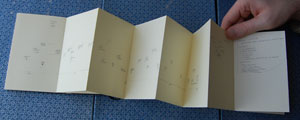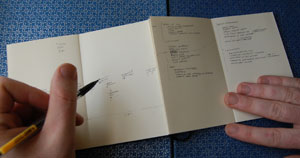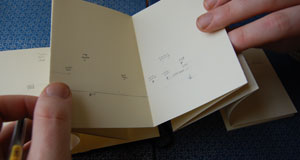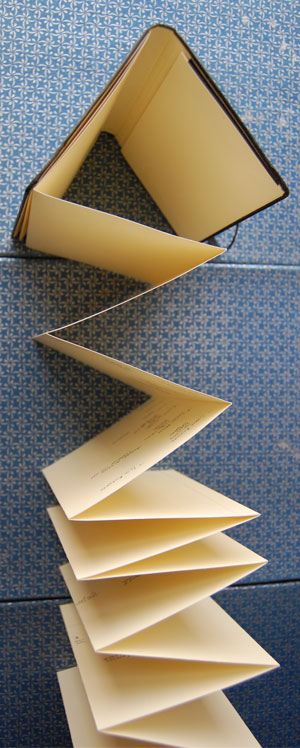moleskining
A good writing journal or notebook is a blend of aesthetics and functionality, both highly personal things. I've had dozens over the years, and many of them have been filled only a quarter of the way through (usually starting at the back and moving toward the front), due to a failing in one of these two concerns.
I've got tiny handwriting. Printing, actually. A typical x-height for me is between 1 and 1.5mm. Thus any sort of ruled journal is unsuitable, unless there's a journal with line-heights around 2.5mm. But a standard journal has line-heights between 8 and 12mm. And ruled journals get in the way of drawing associations between ideas.
I like grid paper more. But my diminutive script tends to get lost on large sheets of graph paper. The Moleskine graph journal is a nice size, and was, until recently, my journal of choice. But it's paper weight isn't quite as nice as the lovely thick weight of other Moleskine journals.
For those not familiar with Moleskine journals, they're worth doing some research on. They've got a literary history that must be enviable amongst journals, and their elegance and simplicity has earned them a sizeable following, as is evident on websites such as www.moleskinerie.com. But the standard unlined moleskine journal just never felt right to me, despite their nice design and perfect size.
Recently, I picked up the Moleskine Japanese Pocket Notebook. The japanese pockets are what you might call accordian folds: the entire thing can be unfolded into a single 31 page spread. I picked one up as a place to store thoughts for my next novel, and the more I use it, the more I am amazed at the elegance of this handy little book.

An excellent example of the versatility of the notebook is on the pages I use for a timeline. The timeline spans six pages, and, when I'm in transit or another situation where space is tight, I can flip between them as standard pages. But when I have room to spread it out, I can open it up to a single six-page spread roughly 21 inches long: that's a longer continuous drawing surface than you're going to get from any other style of notbook, and you could stretch it out far longer, if necessary. I've laid out similar spreads for themes, characters, and scenes, and another area set aside for maps.

But the journal really shows its usefulness when I'm working between sections. I begin by laying the journal open to a four page spread (for example four pages of the timeline). And then I flip the left two pages to an earlier section of the notebook that I want to work on or reference (say, character descriptions). At this point, I can work on one two-page spread while referencing another, and the effect is like having two books to work from, rather than one. To look up material that falls between the two sections that I'm working from, I can simply fold the two central pages apart to untuck the interior content.



All of this may sound confusing, but it's a delightfully tactile way of organizing and manipulating one's thoughts.


